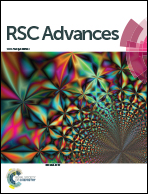Tuning the size and upconversion emission of NaYF4:Yb3+/Pr3+ nanoparticles through Yb3+ doping†
Abstract
We introduce a simple method to tune the resulting size as well as the upconversion luminescence of NaYF4:Yb3+/Pr3+ nanoparticles through varying the sensitizer ytterbium concentration. Various amounts of ytterbium from 10–70% were doped into the fluoride nanoparticles, producing a tunable size from 29 to 153 nm. Meanwhile, the blue upconversion luminescence intensity of NaYF4:Yb3+/Pr3+ nanoparticles was monotonously enhanced, reaching a maximum ∼3.4 fold enhancement at an ytterbium concentration of 70% owing to an improved energy transfer from the ytterbium to the praseodymium ions. Moreover, the luminescence intensity ratio of the blue to the green upconversion was tailored by the composition-dependent cross relaxation process. The result here provides a paradigm for simultaneous control of the physical dimensions as well as the luminescence properties of lanthanide-doped upconversion nanoparticles.


 Please wait while we load your content...
Please wait while we load your content...